 ALFALFA Medicago sativa
ALFALFA Medicago sativa
Alfalfa leaves are rich in the green plant pigment known as chlorophyll, as well as protein, fiber, vitamins, minerals, and nutrients, and hence has been nicknamed as the Father Of All Foods. It has developer a reputation as a natural body cleanser infection fighter and deodorizer. High in fiber, alfalfa also contains eight essential amino acids. Alfalfa is rich in iron, calcium, magnesium, phosphorous, sulfur, sodium, potassium, chlorine and silicon, and is a good source of vitamins A, B, B6, C, D, K, and E.
Traditionally, alfalfa has been used as a herbal remedy in the treatment of arthritis, gout, and rheumatism, and is thought to have a cholesterol-lowering effect. It seems to alleviate asthma and other allergies. It may act as a preventative against cancer, and appears to be able to regulate high blood pressure.
 HORSETAIL Equisetum arvense
HORSETAIL Equisetum arvense
Horsetail is said to be one of the oldest recorded plants on earth, discovered approximately 600 million years ago. It is rich in the trace element silica which aids in the absorption of calcium, and is a basic element int he growth and repair of bone and tissue (strenghtening bones, hair, nails and teeth). Herbalists claim it is useful in the repair and regeneration of the damaged connective tissue associated with rheumatoid arthritis and other connective tissue disorderes. Another long standing use of horsetail has been as a mild treatment in the prevention and treatment of kidney stone formation, bacterial and inflammatory disorders of the lower urinary tract, and as a diuretic.
Horsetail has been a traditional treatment for allergies, pulmonary tuberculosis, cystitis, kidney stones, water retention, fevers, eye diseases, gout, and rheumatism.
 LAVENDER Lavandula angustifolia
LAVENDER Lavandula angustifolia
In an age of extremes lavender is essentially able to produce a balancing and harmonizing effects, by having a pronounced regulating effect on the nervous system. Stress has long been known to deplete the immune system, and can bet he cause, ort he precipitating agent, for all types of illness and disease. With this in mind, lavender is thought to have a restorative effect in cases of a weakened nervous system and have a calming effect on those prone to be stressed or agitated.
For years herbalists have used the calming effects of lavender to treat nervousness, anxiety, worry and depression. Lavender is used as a symptomatic treatment of stress-related conditions. It has been used for insomnia, headaches, and immune as well as digestive problems.
 PASSIONFLOWER Passiflora incarnata
PASSIONFLOWER Passiflora incarnata
Passionflower has found worldwide acclaim in the reduction of nervous trension, alleviating irritability and anxiety, and lowering blood pressure. It i salso used to promote restful sleep. As an antispasmodic it has also been successfully used in the treatment of bronchial asthma.
Passionflower has an overal soothing and calming effect over the entire body, offerning relief from stress and stress-related headaches and pain. It has been employed in the treatment of muscle cramps, premenstrual tension, and disturbances often associated with menopause.
 SIBERIAN GINSENG Eleutherococcus senticosus
SIBERIAN GINSENG Eleutherococcus senticosus
Used in China for over 5000 years, Siberian ginseng has been used as a cure-all for a wide variety of ills. It i sone of the best herbs for the heart and vascular systém, increasing blood flow to the heart and lowering blood pressure. World famous athletes seek out this superior herb for all its restorative and regenerative abilities. When used regularly, Siberian ginseng helps to regulate and harmonize the entire body by increasing the entire body´s energy and healing abilities.
In Asia, Siberian ginseng is a generally accepted treatment in the care of those who have undergone surgery, severe illness, and exhaustion. It helps to prevent a wide variety of debilitating conditions such as diabetes, cancer and cardiovascular disease, and it also has the ability to normalize blood pressure.
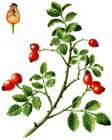 ROSEHIP Rosa canina
ROSEHIP Rosa canina
Rosehips are one of the most natural and freely available sources of vitamin C, as well as containing other important vitamins, minerals and trace elements. Its richness in vitamin C makes it especially attractive in the fight against infections, sore throat and as a preventative measure against colds.
Traditionally recommended for urinary tract infections, rheumatism, gout, kidney disease, water retention and sciatica, as well as a general aid against exhaustion. Rosehips have a mild laxative and slightly diuretic quality.
 GUARANA Paullinia cupana
GUARANA Paullinia cupana
Guarana figures prominently in the social and medicinal culture of the Amazonian Indians. The seed of Guarana has for hundreds of years been used as a general tonic and treatment for many ailments. It holds fast to the claim that it has a stimulating effect on the body, as well as having the ability to dispel pain. Guarana has also developer the reputation of being somewhat of na aphrodisiac.
South Americans reportedly have used Guarana to treat a long list of ailments such as: chronic or infectious diarrhea, headaches (including migraine), pain associated with rheumatism or menstruation, water retention (using it as a diuretic or „water pill“) and hence as an aid in weight losss, fevers, malaria, heat stress and many other ailments.
 CARDAMOM Elettaria cardamomum
CARDAMOM Elettaria cardamomum
For centuries as a spice, cardamom is native to southern India and Sri Lanka, and i salso grown in southeastern Asia and Guatemala. Currently believed to be useful in the treatment of stomach problems, cardamom seems to improve the flow of bile out of the gall bladder, thereby preventing viruses from multiplying.
Herbalists also find cardamom useful against asthma, hemorrhoids, and bad breath, as well as beneficial in strenghtening the body.
 CINNAMON Cinnamomum verum
CINNAMON Cinnamomum verum
Long coveted as a healing aid stomach upset, heartburn and gas, chronic dirrhea, rheumatism, kidney ailments and abdominal pain cinnamon has been used by homeopatic medical practitioners for diarrhea, hemorrhage and cancerous tumors. For years Asians have promoted its use against heart problems, dental pain and urinary problems, believing that it can kill certain bacteria and fungi, improve digestion and help to regulate blood sugar.
Said to fortify the immune system, cinnamon has been used to stimulate the respirátory and circulatory systems, alleviating bronchial coughs, relieve menstrual discomfort, and calm the central nervous system.
 RED CLOVER Trifolium pratense
RED CLOVER Trifolium pratense
Red clover is rich in isoflavones, including genistein and biochanin A (an antioxidant which protects against cell aging). Used as an antibiotic, it has been used in fighting bacterial infections and dealing with kidney and liver diseases. Over the years it has been tried with some success as a tumor and cancer remedy (for breast and prostate cancer in particular). Red clover has also been used as a treatment for skin disorders, such as eczema and psoriasis, as it claims to cleanse the blood.
Herbalists also recommend red clover for reducing uncomfortable menopausal symptoms, and improving overal health, including its use as an expectorant to clear chest congestion caused by coughs, colds, asthma and bronchitis.
 IRISH MOSS Chondrus crispus
IRISH MOSS Chondrus crispus
Harvested from the waters off the European coast, Irish moss is actually a seaweed. Rich in proteins, iodine and other substances, many herbalists also consider it an excellent „nutritive tonic“, and traditionally it has been prescribed for ulcers, dysentery (infectious diarrhea) and other gastrointestinal disorders. Contemporary herbalists consider it a valuable soothing agent (demulcent) for dry coughs, bronchitis, tuberculosis and other upper respirátory tract ailments. It is also thought to help in the treatment and alleviation of peptic and duodenal ulcers.
Considered to have anti-inflammatory, immunosuppressive, blood-pressure lowering, and other potentially beneficial properties, Irish moss i salso thought to have healing properties beneficial in treating ulcers and other problems relating to the digestive system.
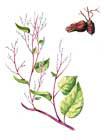 FO-TI Polygonum multiflorum
FO-TI Polygonum multiflorum
This herb has been known and honored in Asia for centuries as a tonic for kidney and liver functions and i tis believed to be a natural antioxidant and free-radical scavenger. It has been shown that it has the ability to strengthen tendons, ligaments, bones, the lower back, and the knees. It also has been reported to prevent premature aging, as well as being beneficial in decreasing blood sugar levels in diabetics, and can act as a natural diuretic. High cholesterol, heart conditions, poor ciruclation, insomnia and chronic bronchitis are among all the conditions that Chinese Fo-Ti-Tieng alleges to help.
Providing strength, resilience and stamina. Chinese Fo-Ti-Tieng is usually recommended as a superior herb for athletes, offering increased energy while rejuvenating the body and acting as a natural anti-inflammatory.
 LICORICE Glycyrrhiza glabra
LICORICE Glycyrrhiza glabra
Long ago, in China, licorice acquired the name of „The Great Detoxifier“. They believed that continuous consumption of licorice root would help to rid the body of poisons and could contribute to the body´s blood building efforts. It has since been used in many Chinese prescriptions treating dry coughs and lung disorders, asthma, sore throats, laryngitis, ulcers, as well as inflammation of the urinary and intestinal tracts. It is said that licorice root increases vital energy, and that it is able to strengthen digestive and metabolic function. It is believed that licorice root „harmonizes“the ingredients in an herbal formulation and eliminates any harshness, thus promoting smooth aktivity of the herbs.
Licorice is useful in the treatment of peptic ulcers, abdominal colic, stomach inflammation, colitis, and has been used as an expectorant in cases of bronchitis.
 BLESSED THISTLE Cnicus benedictus
BLESSED THISTLE Cnicus benedictus
Throughout the years blessed thistle has developer the reputation of being a bit of a cure-all and a potent anti-inflammatory, and it was even believed to have fought off the “great plague”in Europe. It claims to have the ability to lower fever, dissolve blood clots, control bleeding, and reduce rheumatic pain. It has also long been esteemed for controlling menstrual pain and regulating the menstrual cycle. Also believed to offer relief for those suffering from headaches and migraines.
Blessed thistle seems to be genuinely useful in aiding digestive problems, aiding poor digestion (especially in the breaking down of fats), and revitalizing a sluggish liver. Blessed thistle also seems helpful in alleviating stress adn depression, strenghtening the heart, healing the liver, and improving circulation.
 FENNEL Foeniculum vulgare
FENNEL Foeniculum vulgare
One of the oldest medicinal plants, fennel has reportedly been in use for over 4,000 years. Alleged to stimulate the movement of food through the stomach and intenstines, it is useful as a digestive aid, and seems to remedy mild spasm in the stomach and intestines, a feeling of fullness, and intestinal and gastric distress. It also claims to have a calming effect on bronchitis and is a superb remedy for coughs and stubborn mucus.
In Asian medicine, fennel seed is recommended for instances of anemia, bloating, heartburn, vomiting, diarrhea, hernia, and skin diseases.
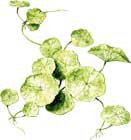 GOTU KOLA Centella asiatica
GOTU KOLA Centella asiatica
Rich in vitamins A, B, E, G and K as well as magnesium, Gotu Kola has long been helpful in the treatment of asthma, bronchitis, heart problems, dysentery, insomnia, eye conditions, exhaustion, inflammation, high blood pressure, diarrhea and problems with urination. Often referred to as „food for the brain“, taken on a regular basis, this herb has become known as the „key to longevity“ in humans, and seems to be able to enhance intelligence and improve memory, increasing mental and physical power, combating stress and improving the reflexes.
Gotu Kola nourishes the nervous systém, especially the brain, boosting energy levels, helping to fight depression, and reducing sleep disorders. Contemporary Western herbalists have long cited the wound-healing actions of Gotu Kola.
 YELLOW GENTIAN Gentiana lutea
YELLOW GENTIAN Gentiana lutea
Used in the Middle Ages as an antidote for certain poisons and in the treatment of gout and rheumatism, this her bis thought to have antibacterial and anti-inflammatory properties. Said to stimulate the appetite, promote secretion of salivary, gastric, liver, pancreatic and intestinal juices, it accelerates emptying of the stomach and alleviates indigestion, bloating and flatulence.
In its original state, yellow gentian is a very bitter tasting herb. For centuries it has been used to stimulate the gall bladder and pankreas, as well as the stomach, improving digestive and liver function.
 THYME Thymus vulgaris
THYME Thymus vulgaris
Used from the middle ages onward for its medicinal properties, thyme´s antispasmodic and expectorant properties have been relied upon to treat chronic bronchitis (helping to loosen phlegm and combat bronchial spasm), bronchial asthma, reducing hay fever, chronic gastritis and digestive disorders.
As an antiseptic and antibacterial, thyme has been used in the treatment of inflamed sinuses, nose, throat, and larynx, and has a history as a remedy for whooping cough.
 YARROW Achillea millefolium
YARROW Achillea millefolium
Used since medieval times, yarrow was looked upon as a headache cure, its anti-inflammatory properties seeming to have the ability to reduce headaches and blood clotting. Yarrow has been one of the most popular treatments for arthritis and related conditions, alleviating painfull inflammation of tissues and joints. Historically it has also been used to fight bacterial invasion and treat wounds. Yarrow has also been used to soothe and quiet the digestive system.
Because of the substances contained in yarrow, a feeling of peace and relaxation have been known to be replicated thus making it effective in treating sleeping disorders. This also makes yarrow particularly beneficial in the treatment of some of the effects of menopause.
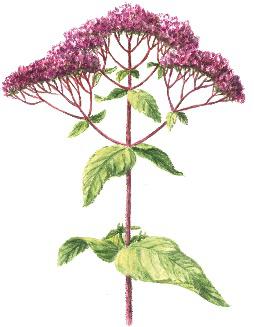 BONESET Eupatorium perfoliatum
BONESET Eupatorium perfoliatum
The American Indians introduced the use of boneset to the early settlers for the treatment of colds, influenza, rheumatism, indigestion, constipation, and all kinds of fevers. There is the suggestion that boneset has the ability to rev up the immune system in response to infection and can clear the upper respirátory tract of mucus congestion, offering relief from colds and flu.
There is supporting evidence that as an anti-inflammatory, boneset lends itself to the treatment of arthritis and the possibility that the immune stimulants in boneset may have anti-cancer attributes.
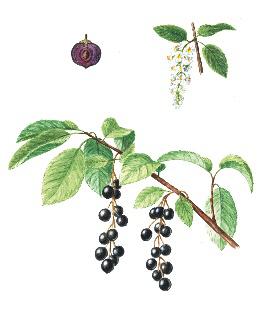 WILD CHERRY Prunus serotina
WILD CHERRY Prunus serotina
Generally used as a pain reliever, wild cherry´s most popular claim to fame is that this her bis well known to break down and expel kidney stones. Wild cherry contains beta carotene and vitamin A. long valued as a treatment against colds, coughs, and diarrhea, it is also used in the treatment of lung ailments, in particular, the treatment of whooping cough, bronchitis, pneumonia and other similar disorders.
Herbalists today recommend wild cherry for respirátory ailments such as coughs, colds, and bronchitis, and consider it effective for its calming effect, relieving anxiety, stress and sleeplessness.
 ALOE Aloe vera
ALOE Aloe vera
Aloe has played a role in herbal medicine since the 4th century BC, when it was externally applied to heal wounds, bruises and skin irritations. An extract taken from the leaf was used internally as a tonic, purgative and jaundice remedy. Modern medicine is consistently finding new uses for aloe – for example; the fresh juice can be employed as a salve in the treatment of burns, sunburns and insect bites.
Aloe has been commonly used as a remedy for indigestion, hardening of the arteries, diabetes, menstrual problems, infections, tumors, skin diseases, water retention, in the alleviation of arthritis
and as a cleanser for the liver, kidneys, spleen and bladder.
 KOREAN GINSENG Panax ginseng
KOREAN GINSENG Panax ginseng
The Chinese have long used Korean ginseng in their health practices, claiming it has the power to balance one´s energy. It appears to have the quality to help regulate and strenghten body functions, improving metabolism, increasing both immune systém resistence and respirátory performance. Extracts from this herb have been used to provide a mental stimulant, thought to improve memory and cognitive ower, and many claim that with regular use it can ofthen reverse mental deterioration. It can also lessen the effects of menopause.
Among its many uses, Korean ginseng is beneficial in treating fatigue, providing increased physical energy, increasing metabolism, hastening recovery from illness and surgery, and empowering its users with an increased alertness and power of concentration, as well as instilling a general sense of well-being and vitality.
 GINKGO BILOBA Ginkgo biloba
GINKGO BILOBA Ginkgo biloba
Ginkgo biloba is the most powerful antioxidant known today and as such is said to help prevent degenerative conditions of the heart, arteries, eyes, ears and other organs, as well as shielding the brain from the effects of stress, toxins and aging. For hundreds of years, traditional Chinese physicians have used ginkgo to treat impotence. It is thought that ginkgolides act by reducing inflammation around small airways in the lungs, and in doing so can offer some aid to asthma and allergy sufferers.
Ginkgo is the most broad-spectrum medicine that is known today. It contains so many different active ingredients that no single one of them can account for all of the extract´s healing power. Instead, they act synergistically – creating an overal effect that is greater than the sum of all of its parts.
 BLADDERWRACK Fucus vesiculosus
BLADDERWRACK Fucus vesiculosus
Harvested from the oceans, bladderwrack is a seaweed. It contains both iodine and carotene which are necessary for proper thyroid function. Herbalists tend to agree that bladderwrack is effective in the treatment of an underactive thyroid gland, and i salso useful in the treatment of goiter. Where obesity is associated with thyroid trouble, this her bis thought to be helpful in reducing excess weight.
Bladderwrack is reputed to be helpful in the relief of rheumatioid arthritis, inflammation of the bladder, and as a remedy for high cholesterol and hardening of the arteries.
 CAYENNE Capsicum frutescens
CAYENNE Capsicum frutescens
A natural stimulant, cayenne seemingly aids circulatory function by feeding the necessary elements info the cell structure of the arteries, veins, and capillaries so that these regain some of the elasticity of youth, allowing the blood pressure to adjust itself to normal. It also stimulates the digestive system, and has been used for treatment against stomachaches, cramps, gas, indigestion, loss of appetite, diarrhea and various fevers. Rich in carotenoids and vitamin C and E: these antioxidants are thought to protect against free radicals and reduce the risk of cancer. Cayenne also appears to be useful in enhancing the aktivity of various immune systems.
Capsaicin, the active ingredient in cayenne, seems to be able to deaden painsensing nerves, even when the cause remains present.
Alveo Grape:
CONCORD GRAPES
It has been determined that biologically active flavonoids: a natural substance found in red grapes (their juice, pulp, skin, seed and stems) contain some of the most powerful antioxidants yet discovered, and have been hailed to be up to seven times more potent than those found in the vitamins C, E and beta-carotene. Flavonoids are important for neutralizin harmful free radicals, which may be a root cause of many chronic and degenerative diseases such as certain itself. The assumption is that red grapes tend to reduce blood platelet stickiness, allowing the blood to flow more smoothly through the vessels, thereby reducing risk of heart attack and stroke. ALVEO® is an excellent daily source of pure and natural red grape juice to enhance your nutritional health.
The above information is in part provided as general medical information from the American Heart Association.
CANADIAN MAPLE SYRUP
Canadian maple syrup is an entirely natural product that contains potassium, calcium, magnesium, phosphorus, iron and zinc. It i salso rich in the vitamins niacin, pantothenic acid, riboflavin, as well as containing traces of folic acid, vitamin A and vitamin B6. This means that maple syrup is a healthy sweetener, and a wonderful ingredient that has been added to the ALVEO® formulation to provide a natural sweetness for your enjoyment!
BUCKWHEAT HONEY
Honey logn ago acquired the reputation of providing important nutrients, high in vitamins C, B1 and B2, minerals and other nutritious components. It i salso a natural sweetener, and has been hailed as an energy booster. Traditional Chinese herbalists have long supported the healing properties of honey. It has been used as a soothing remedy for coughs and sore throats, as a wound-healing antiseptic, a sleeping agent, a cure for diarrhea, an asthma remedy, and as a treatment for many skin conditions.
Alveo Mint:
PEPPERMINT Mentioned in medical literature as early as the 1700´s, peppermint is regarded as a stimulant which can restore proper function to the stomach and can promote digestion by stimulating the production of bile in the liver, helping to break down fats. Thought to reduce muscle spasms, it has been used as a remedy for irritable bowel syndrome and other related ailments. Its antibacterial and antiviral qualities make it a great infection fighter, which lends itself well to the clearing of congestion in the nose, sinuses, and bronchial passages and more generally as a common cold and flu remedy.
As adigestive aid, peppermint seems to reduce bloating, soothe abdominal pain and helps to stop vomiting. It also seems to reduce nauzea and mornign sickness. Peppermint is used to promote relief from muscular tension and has been known to offer relief from stress and migraine headaches.
 Alveo Canada
Alveo Canada